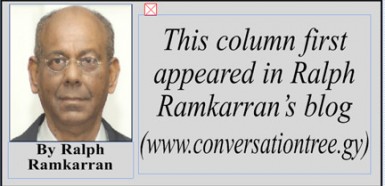
May 28, 2017
This weekend Guyana celebrates the 51st Independence Anniversary, offers national awards to worthy citizens on their contributions to Guyana and welcomes the uplifting message of Ramadan. The most inspiring message at this time, however, are those of the two major political parties, combined in the headline of this article. The common theme is reflected in the use of the words “unity” in one message and “cohesive” in the other.
Guyana is still referred to as a land of six peoples even though most of the Portuguese, Chinese and Europeans left in the 1960s and 1970s. Prominent groups which now exercise political influence are Amerindians, generally supportive of the PPP, and the Mixed Group, a large section of which is supportive of APNU. But the largest groups, comprising almost seventy per cent of the population, with the most decisive influence on the political direction of Guyana, consist of African and Indians.
Africans and Indians, and Amerindians for that matter, are peoples of differing ethnic, cultural, historical and religious backgrounds. Living under the same Guyana roof has resulted in knowledge, degrees of understanding and some appreciation of our differing historical experiences and cultural and religious practices. But the reality is that the main ethnic groups in Guyana live compartmentalized lives, whether in mixed communities or not, separated by our differences, and hardly ever interacting socially, culturally or politically. We are different nations, living separate lives, subsisting in the same homeland and competing for scarce resources. Most believe that partisanship has always determined how those resources are distributed and each side has the ‘proof’ of as many examples as the other to justify the argument of discrimination and the need for redress.
Guyana’s political course is no different from any other country with large ethnic groups. Our political parties have developed around our two large ethnic groups which, through ethnic based political parties, compete with each other for political power. The intensity of the competition is conditioned by our own development. It is intense in Guyana, perhaps conditioned by the killings, burnings and lootings of the 1960s and political disturbances more recently, but benign in Trinidad, which has a similar ethnic make-up and ethnically based political parties, but has had no ethno/political violence. On the other hand, centuries of discrimination against Catholics, resulted in a virtual civil war in Northern Ireland, which was settled by a permanent coalition arrangement between the parties representing Catholics and Protestants.
Guyana’s ethno/political rivalry has long created such a level of instability that it has become one of the main obstacles to economic growth. Many experts have so concluded and the high level of political risk insurance for foreign investment demonstrates this. With ethno/political division being the major ‘problematic’ in Guyana’s politics, it has now become routine political correctness to call for unity and cohesion. While this is a laudable objective, it is a long-term project and progress would be slow and imperceptible. It would not bring down the level of political instability to that required to deal with the challenges and complexities of an economy soon to experience a massive increase in resources in a weak and inexperienced regulatory environment where corruption is still pervasive.
Other challenges relate to continued corruption and disquiet about the next elections. Despite the loud talk, new policing laws and institutions, no dent in corruption has been noticed. It is as pervasive as it was in the past though less noticeable because there is less government spending. This tells us that the culture of corruption, once entrenched, is extremely difficult to eradicate. On the elections front, the rejection by President Granger of the first list for Chair of the Elections Commission submitted by the Leader of the Opposition was unexpected and surprising. If the rumours that the second list is also to be rejected proves to be true, serious questions will emerge as to whether the APNU+AFC coalition government wants an independent Chair and, if not, why not.
It is because of all these issues facing Guyana, undergirded by a political structure in which neither major ethnic group has confidence unless that group is perceived to control political power, that the Carter Center has called for constitutional reform.
It said that the anticipated influx of oil revenue “has the potential to exacerbate ethnic and political conflicts.” It recommends separate presidential elections, possibly with candidates ranked by voters in a preferred scale with the person gaining the highest total votes being the winner. This allegedly helps to eliminate the impact of ethnic voting.
However, it is APNU+AFC which has shown the way and the PPP has not rejected constitutional reform either in principle or APNU+AFC proposals. The APNU+AFC has proposed in its last manifesto the following: separate presidential elections; the requirement for 50 per cent +1 to win; the person who brings second in the presidential race to become the prime minister; and every party that wins 15 per cent or more of the votes to be entitled to seats in the government.
The time has come for APNU+AFC and the PPP to end the deadlock and get on with what they both promised. Granger and Jagdeo must talk about constitutional reform and find a way to get the process moving.
